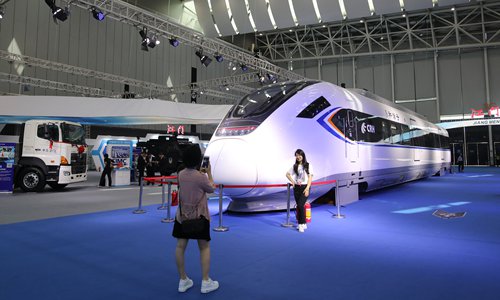Trial standards released for maglev railway technology
2019-09-26 09:37:49
Summary:A visitor poses for photos before a model of a maglev train in Foshan, South China's Guangdong Province on ...

A visitor poses for photos before a model of a maglev train in Foshan, South China's Guangdong Province on Friday. Photo: VCG
Trial technology standards aimed at standardizing the construction and equipment manufacturing of maglev railways in China were released on Wednesday - a step further in the development of the ultra-fast and environmentally friendly train.
The trial standards will serve as basic industry standards and will come into effect on January 1, 2020. They will promote the sound development of the maglev railway industry in China, the National Railway Administration said in a statement.
The goal is to lead the sustainable development of maglev railways and promote China into a transportation power by unifying the basic technical requirements such as the track gauge and track reference level, and defining the main technical specifications for maglev vehicles.
Maglev railways have obvious advantages over traditional transport such as high-speed railways and airplanes in terms of speed, energy costs and environmental friendliness.
For instance, at a speed of 500 kilometers per hour, the energy consumption of maglev trains per seat per kilometer is only one-third to one-half of that of aircraft.
China has been stepping up efforts in the development of maglev trains in recent years, carrying out research projects on the key technology of maglev transportation systems with a speed of 600 kilometers per hour.
China has also been gaining experience from maglev lines in operation in Shanghai, Beijing and Changsha, Central China's Hunan Province.
In April 2006, the Shanghai maglev line was completed and put into operation, with a maximum operation speed of 430 kilometers per hour. It is the world's first high-speed maglev line to be in commercial operation.
In May 2019, a prototype vehicle with a speed of 600 kilometers per hour rolled off the production line in Qingdao, East China's Shandong Province, a major breakthrough in high-speed maglev technology in China.
